Calibration of Waveplate Retardance Fluctuation Due to Field-of-View Effect in Mueller Matrix Ellipsometer
Abstract
:1. Introduction
2. Characterization of the Waveplate
3. System and Calibration Method
3.1. Single-Wavelength Mueller Matrix Ellipsometer System
3.2. Calibration of the Waveplate Retardance Fluctuation
4. Experiments and Results
5. Conclusions
Author Contributions
Funding
Institutional Review Board Statement
Informed Consent Statement
Data Availability Statement
Conflicts of Interest
References
- Lee, S.H.; Kim, M.Y.; Ser, J.-I.; Park, J. Asymmetric polarization-based frequency scanning interferometer. Opt. Express 2015, 23, 7333–7344. [Google Scholar] [CrossRef]
- Liu, L.; Zeng, A.; Zhu, L.; Huang, H. Lateral shearing interferometer with variable shearing for measurement of a small beam. Opt. Lett. 2014, 39, 1992–1995. [Google Scholar] [CrossRef]
- Sato, T.; Araki, T.; Sasaki, Y.; Tsuru, T.; Tadokoro, T.; Kawakami, S. Compact ellipsometer employing a static polarimeter module with arrayed polarizer and wave-plate elements. Appl. Opt. 2007, 46, 4963–4967. [Google Scholar] [CrossRef] [PubMed]
- Aspnes, D.E. Spectroscopic ellipsometry—Past, present, and future. Thin Solid Films 2014, 571, 334–344. [Google Scholar] [CrossRef]
- Aas, L.M.S.; Ellingsen, P.G.; Fladmark, B.E.; Letnes, P.A.; Kildemo, M. Overdetermined broadband spectroscopic Mueller matrix polarimeter designed by genetic algorithms. Opt. Express 2013, 2021, 8753–8762. [Google Scholar] [CrossRef] [PubMed]
- De Martino, A.; Kim, Y.-K.; Garcia-Caurel, E.; Laude, B.; Drévillon, B. Optimized Mueller polarimeter with liquid crystals. Opt. Lett. 2003, 28, 616–618. [Google Scholar] [CrossRef]
- Williams, P.A. Rotating-wave-plate Stokes polarimeter for differential group delay measurements of polarization-mode dispersion. Appl. Opt. 1999, 38, 6508–6515. [Google Scholar] [CrossRef]
- Aspnes, D.E.; Studna, A.A. High Precision Scanning Ellipsometer. Appl. Opt. 1975, 14, 220–228. [Google Scholar] [CrossRef]
- Azzam, R.M.A. Photopolarimetric measurement of the Mueller matrix by Fourier analysis of a single detected signal. Opt. Lett. 1978, 2, 148–150. [Google Scholar] [CrossRef]
- Sun, C.; Ye, S.; Jian, S. Solc-Like Tunable Birefringent Fiber Filter Based on Elliptical-Core Spun Fiber. IEEE Photonics Technol. Lett. 2017, 29, 1031–1034. [Google Scholar] [CrossRef]
- Demirbas, U.; Uecker, R.; Fujimoto, J.G.; Leitenstorfer, A. Multicolor lasers using birefringent filters: Experimental demonstration with Cr:Nd:GSGG and Cr:LiSAF. Opt. Express 2017, 25, 2594–2607. [Google Scholar] [CrossRef] [PubMed]
- Hagen, N.; Yoshida, K.; Shan, Y.; Otani, Y. Apophyllite waveplates. Appl. Opt. 2022, 61, 6518–6526. [Google Scholar] [CrossRef] [PubMed]
- Emam-Ismail, M. Experimental realization of short-wavelength infrared half wave retarder fabricated from ZnO single crystal plates. Opt. Mater. 2023, 135, 113297. [Google Scholar] [CrossRef]
- Emam-Ismail, M. Wide spectral range multiple orders and half-wave achromatic phase retarders fabricated from two lithium tantalite single crystal plates. Opt. Laser Technol. 2015, 74, 108–118. [Google Scholar] [CrossRef]
- Emam-Ismail, M. Experimental realization of multi, zero, dual order and achromatic gypsum wave plate in a wavelength range 400–1000 nm. Opt. Commun. 2013, 292, 18–24. [Google Scholar] [CrossRef]
- Boulbry, B.; Bousquet, B.; Jeune, B.L.; Guern, Y.; Lotrian, J. Polarization errors associated with zero-order achromatic quarter-wave plates in the whole visible spectral range. Opt. Express 2001, 9, 225–235. [Google Scholar] [CrossRef]
- Dai, H.; Yan, C. Measurement errors resulted from misalignment errors of the retarder in a rotating-retarder complete Stokes polarimeter. Opt. Express 2014, 22, 11869–11883. [Google Scholar] [CrossRef]
- Dong, H.; Tang, M.; Gong, Y. Measurement errors induced by deformation of optical axes of achromatic waveplate retarders in RRFP Stokes polarimeters. Opt. Express 2012, 20, 26649–26666. [Google Scholar] [CrossRef]
- Lee, J.; Rovira, P.I.; An, I.; Collins, R.W. Alignment and calibration of the MgF2 biplate compensator for applications in rotating-compensator multichannel ellipsometry. J. Opt. Soc. Am. A 2001, 18, 1980–1985. [Google Scholar] [CrossRef]
- Zhang, S.; Jiang, H.; Gu, H.; Chen, X.; Liu, S. Attitude metrology based on the field-of-view effect of birefringence using high-speed polarimetry. Opt. Lett. 2020, 45, 2074–2077. [Google Scholar] [CrossRef]
- Gu, H.; Chen, X.; Zhang, C.; Jiang, H.; Liu, S. Study of the retardance of a birefringent waveplate at tilt incidence by Mueller matrix ellipsometer. J. Opt. 2018, 20, 015401. [Google Scholar] [CrossRef]
- Hsieh, C.H.; Tsai, C.C.; Wei, H.C.; Yu, L.P.; Wu, J.S.; Chou, C. Determination of retardation parameters of multiple-order wave plate using a phase-sensitive heterodyne ellipsometer. Appl. Opt. 2007, 46, 5944–5950. [Google Scholar] [CrossRef] [PubMed]
- Arteaga, O.; Canillas, A.; Jellison, G.E., Jr. Determination of the components of the gyration tensor of quartz by oblique incidence transmission two-modulator generalized ellipsometry. Appl. Opt. 2009, 48, 5307–5317. [Google Scholar] [CrossRef] [PubMed]
- West, E.A.; Smith, M.H. Polarization errors associated with birefringent waveplates. Opt. Eng. 1995, 2265, 1574–1580. [Google Scholar] [CrossRef]
- Ruder, A.; Wright, B.; Peev, D.; Feder, R.; Kilic, U.; Hilfiker, M.; Schubert, E.; Herzinger, C.M.; Schubert, M. Mueller matrix ellipsometer using dual continuously rotating anisotropic mirrors. Opt. Lett. 2020, 45, 3541–3544. [Google Scholar] [CrossRef]
- Fujiwara, H. Spectroscopic Ellipsometry: Principles and Applications; John Wiley & Sons: Chichester, UK, 2007; pp. 52–59. [Google Scholar]
- Liao, C.C.; Lo, Y.L. Extraction of anisotropic parameters of turbid media using hybrid model comprising differential-and decomposition-based Mueller matrices. Opt. Express 2013, 21, 16831–16853. [Google Scholar] [CrossRef]
- Veiras, F.E.; Perez, L.I.; Garea, M.T. Phase shift formulas in uniaxial media: An application to waveplates. Appl. Opt. 2010, 49, 2769–2777. [Google Scholar] [CrossRef]
- Avendaño-Alejo, M.; Rosete-Aguilar, M. Optical path difference in a plane-parallel uniaxial plate. J. Opt. Soc. Am. A 2006, 234, 926–932. [Google Scholar] [CrossRef]
- Bass, M.; Van Stryland, E.W.; Williams, D.R.; Wolfe, W.L. Handbook of Optics; McGraw-Hill: New York, NY, USA, 1995; pp. 15.1–15.100. [Google Scholar]
- Pezzaniti, J.L.; Chipman, R.A. Angular dependence of polarizing beam-splitter cubes. Appl. Opt. 1994, 33, 1916–1929. [Google Scholar] [CrossRef]
- Lo, Y.-L.; Pham, T.-T.-H.; Chen, P.-C. Characterization on five effective parameters of anisotropic optical material using Stokes parameters—Demonstration by a fiber-type polarimeter. Opt. Express 2010, 18, 9133–9150. [Google Scholar] [CrossRef]
- El-Agez, T.M.; Taya, S.A. Development and construction of rotating polarizer analyzer ellipsometer. Opt. Lasers Eng. 2011, 49, 507–513. [Google Scholar] [CrossRef]
- Argenti, F.; Torricelli, G.; Alparone, L. MMSE filtering of generalised signal-dependent noise in spatial and shift-invariant wavelet domains. Signal Process. 2006, 86, 2056–2066. [Google Scholar] [CrossRef]
- Novikova, T.; Bulkin, P. Inverse problem of Mueller polarimetry for metrological applications. J. Inverse Ill-Posed Probl. 2021, 29, 759–774. [Google Scholar] [CrossRef]




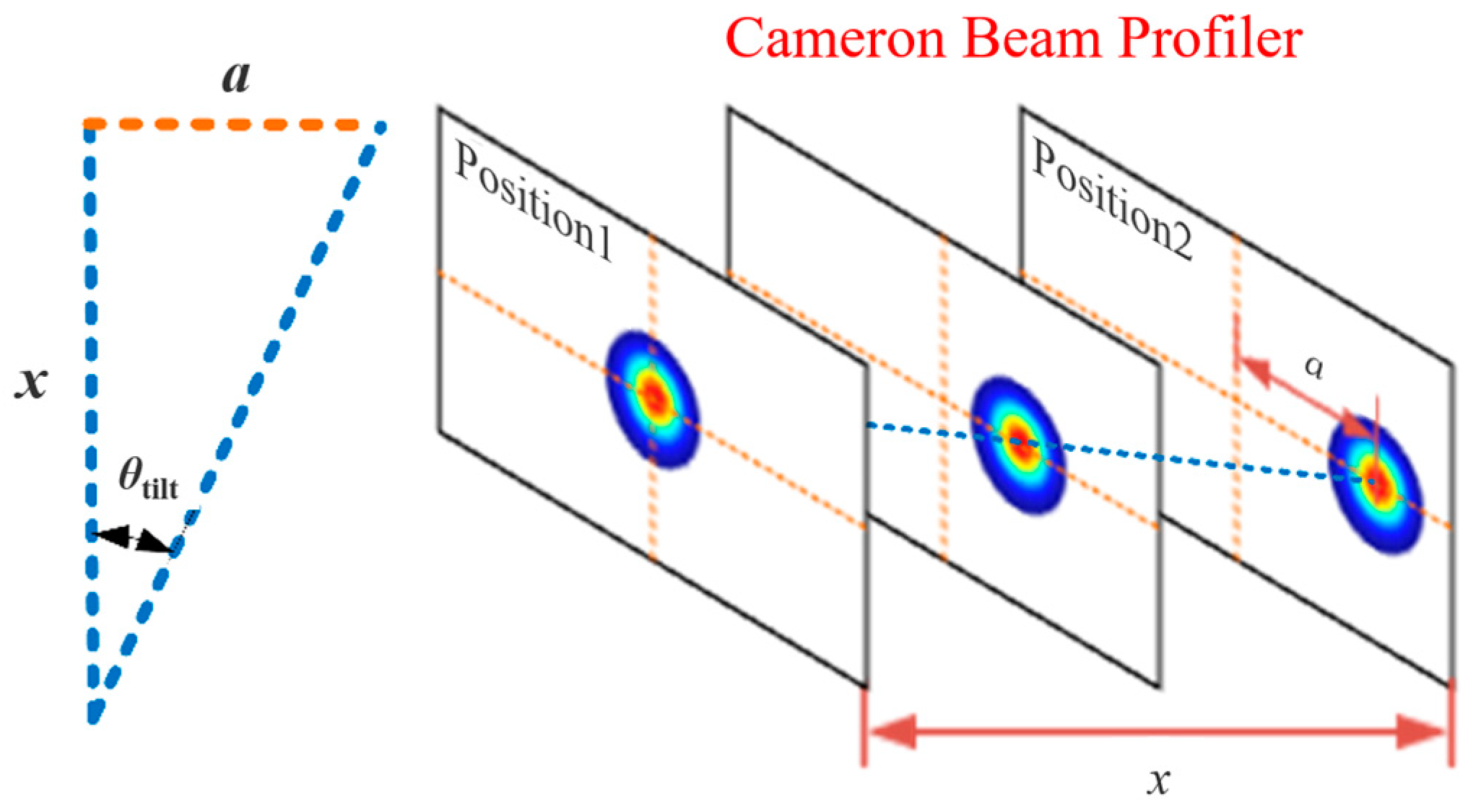
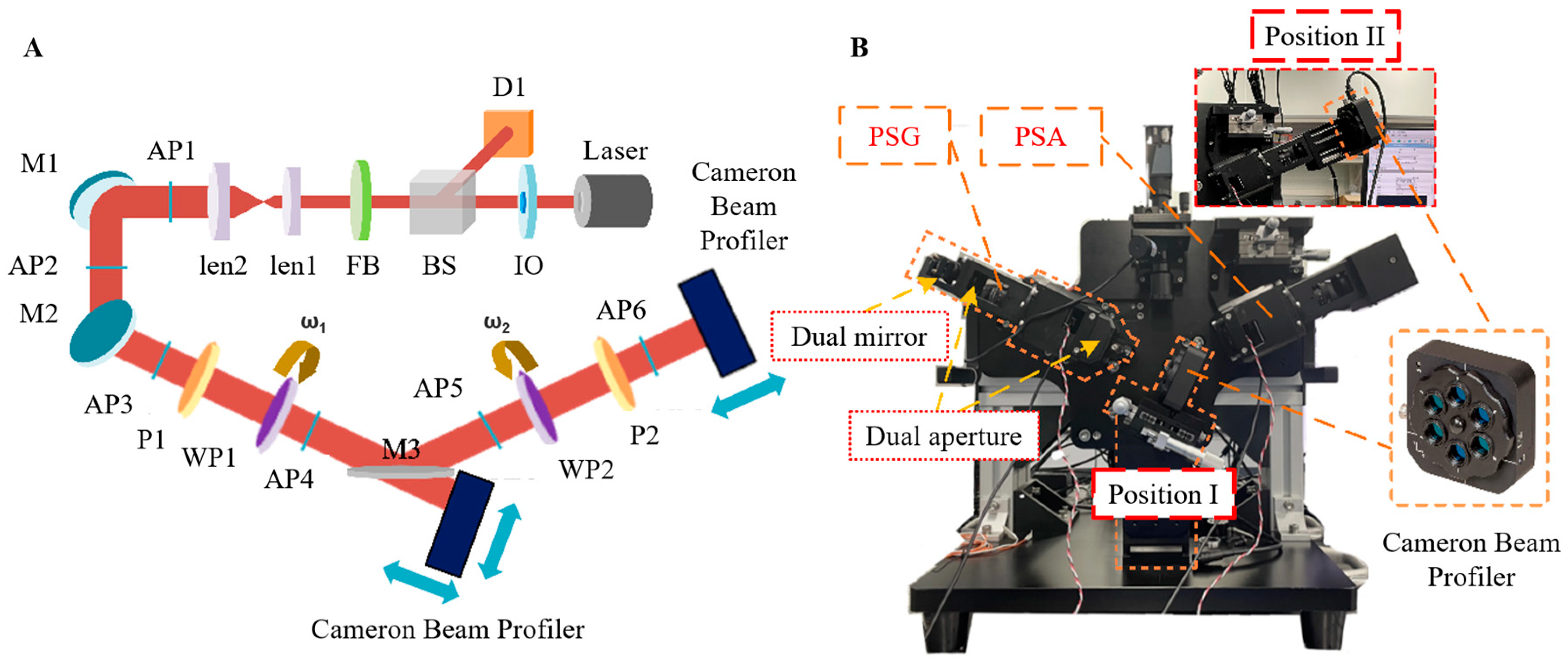

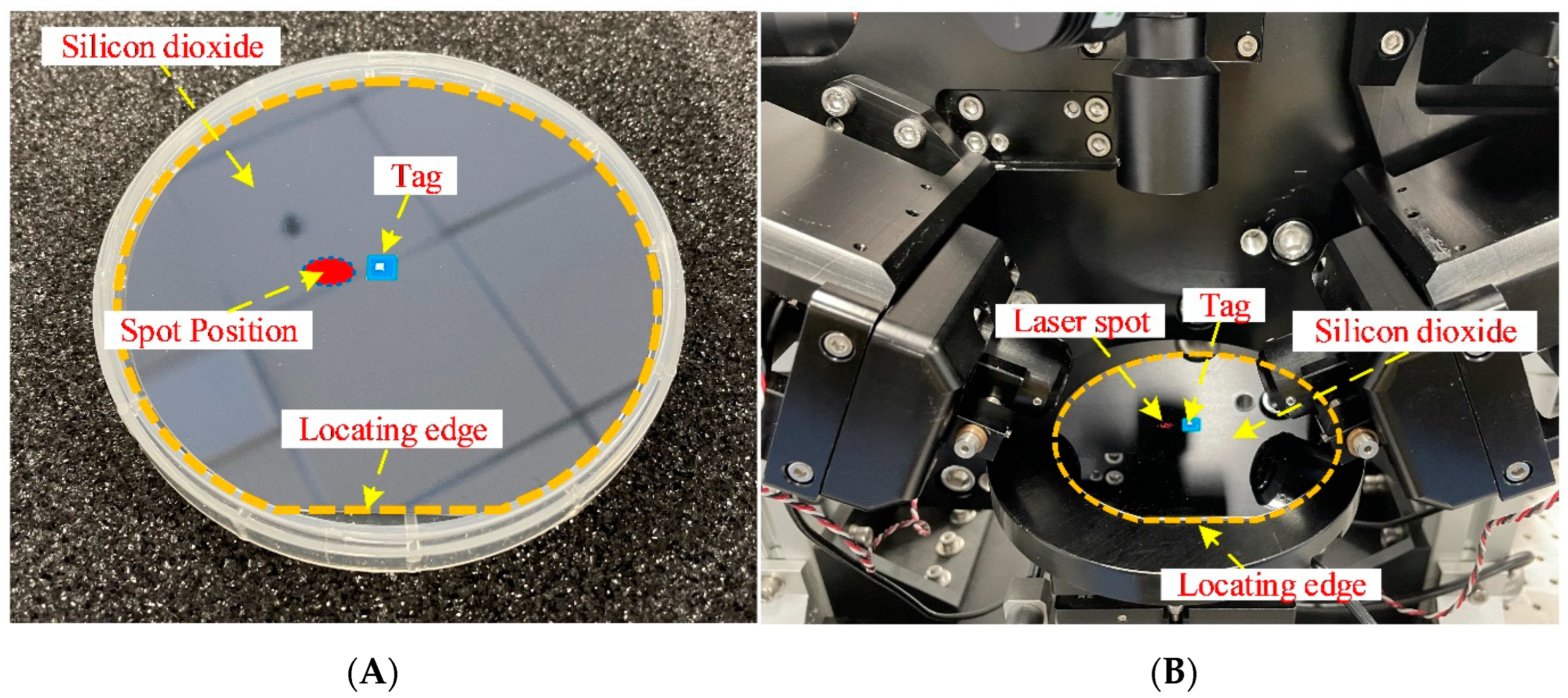
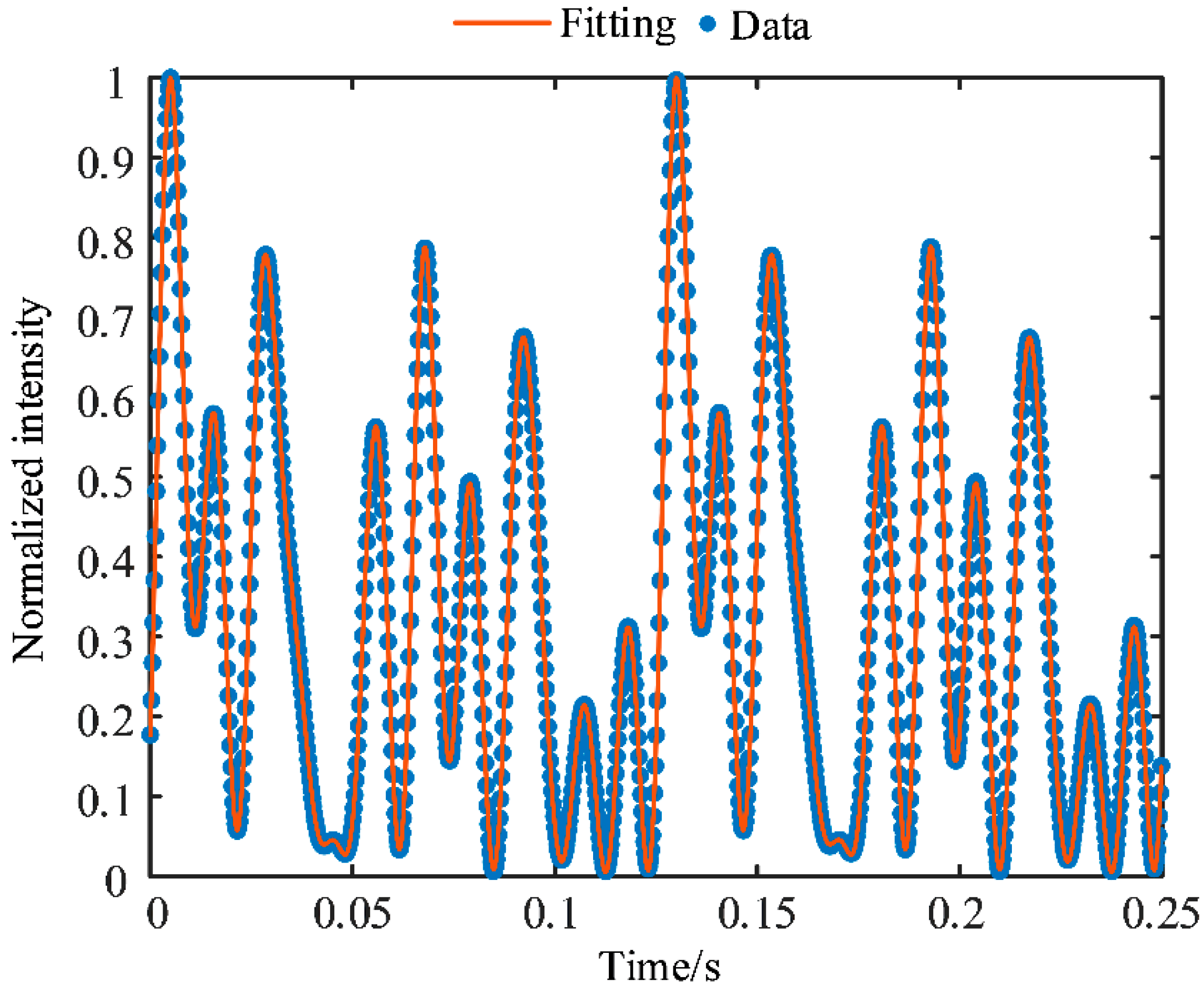
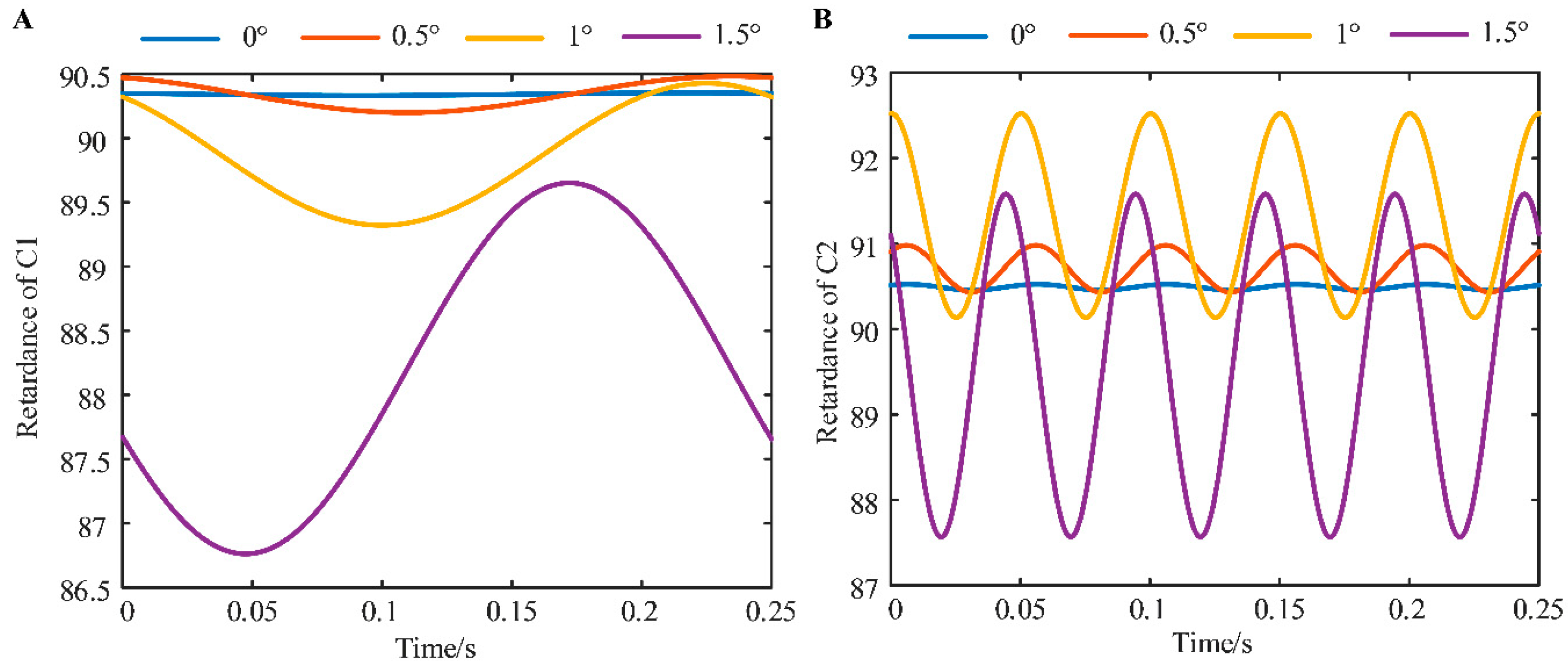
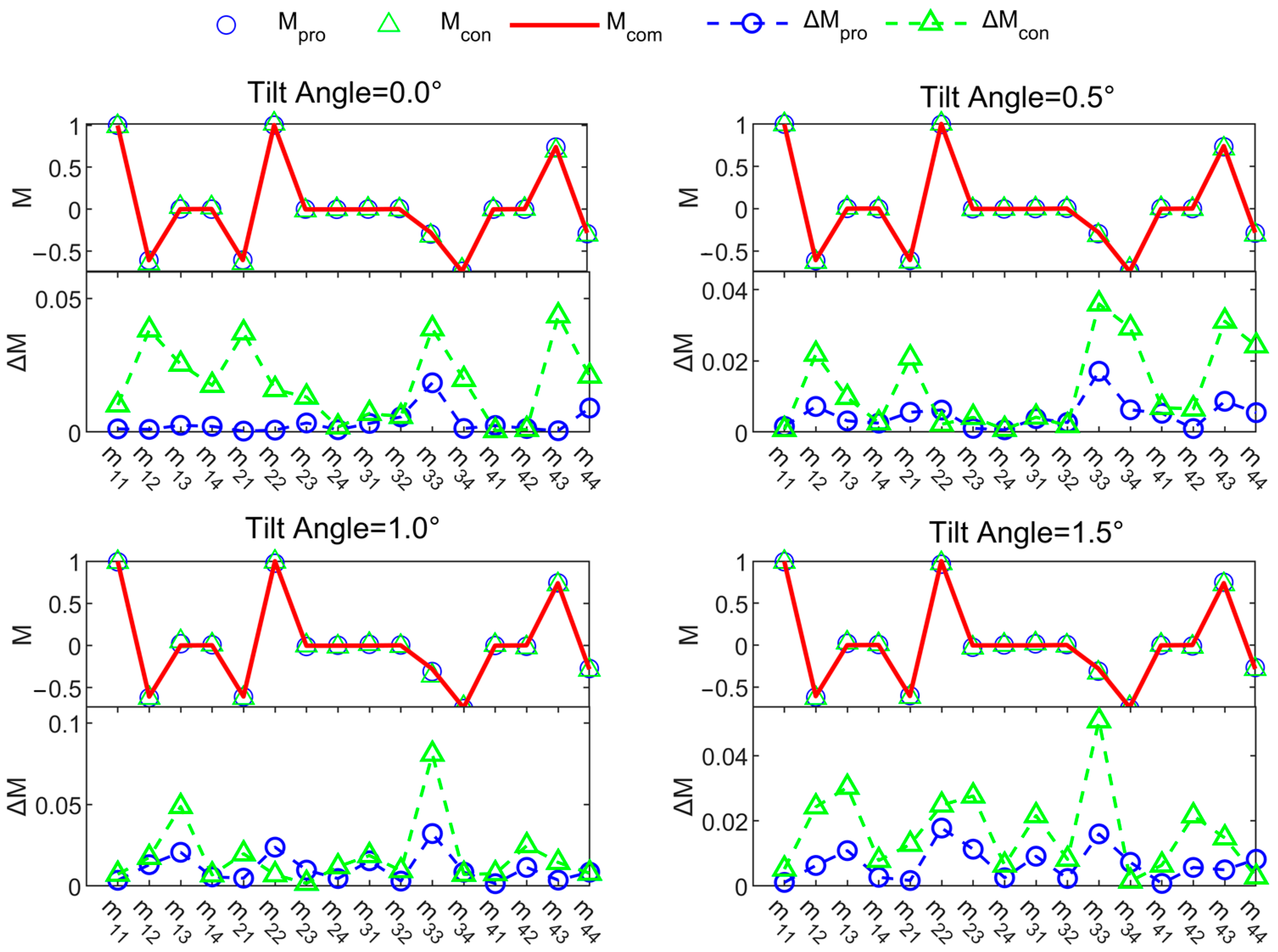
| Tilt Angle (°) (Absolute Value) | System Parameters | System Parameters | System Parameters | ||||
|---|---|---|---|---|---|---|---|
| 0 | P (°) | 33.530 | ω2 (°/s) | 7200.006 | b2 | 0.012 | |
| A (°) | 28.650 | AC1 | −0.011 | c2 | 0.003 | ||
| Dt1 | 0.995 | AC2 | 0.034 | θincident (°) | 64.944 | ||
| Dt2 | 0.989 | ϕC1 (°/s) | −42.173 | a0 | −0.003 | ||
| δP (°) | 0 | ϕC2 (°/s) | 42.717 | a1 | 1.010 | ||
| δA (°) | 0 | (°/s) | 90.343 | a2 | −0.037 | ||
| (°) | −41.663 | (°/s) | 90.490 | a3 | 0.029 | ||
| (°) | −62.177 | b1 | −0.001 | ||||
| ω1 (°/s) | 1440.136 | c1 | −0.005 | ||||
| 0.5 | P (°) | 33.561 | ω2 (°/s) | 7200.059 | b2 | 0.010 | |
| A (°) | 28.547 | AC1 | −0.142 | c2 | 0.003 | ||
| Dt1 | 0.995 | AC2 | 0.275 | θincident (°) | 64.944 | ||
| Dt2 | 0.989 | ϕC1 (°/s) | −68.006 | a0 | −0.003 | ||
| δP (°) | 0 | ϕC2 (°/s) | 46.404 | a1 | 1.012 | ||
| δA (°) | 0 | (°/s) | 90.341 | a2 | −0.037 | ||
| (°) | −41.829 | (°/s) | 90.706 | a3 | 0.029 | ||
| (°) | −63.398 | b1 | −0.005 | ||||
| ω1 (°/s) | 1440.382 | c1 | −0.003 | ||||
| 1 | P (°) | 33.655 | ω2 (°/s) | 7200.350 | b2 | 0.019 | |
| A (°) | 28.238 | AC1 | −0.553 | c2 | 0.003 | ||
| Dt1 | 0.990 | AC2 | −1.193 | θincident (°) | 65.360 | ||
| Dt2 | 0.989 | ϕC1 (°/s) | −53.970 | a0 | −0.003 | ||
| δP (°) | 0 | ϕC2 (°/s) | −91.971 | a1 | 1.004 | ||
| δA (°) | 0 | (°/s) | 89.875 | a2 | −0.037 | ||
| (°) | −41.474 | (°/s) | 91.329 | a3 | 0.029 | ||
| (°) | −62.944 | b1 | 0.006 | ||||
| ω1 (°/s) | 1441.193 | c1 | −0.018 | ||||
| 1.5 | P (°) | 33.806 | ω2 (°/s) | 7199.663 | b2 | 0.051 | |
| A (°) | 27.392 | AC1 | −1.445 | c2 | −0.016 | ||
| Dt1 | 0.987 | AC2 | −2.006 | θincident (°) | 65.111 | ||
| Dt2 | 0.989 | ϕC1 (°/s) | 21.634 | a0 | −0.003 | ||
| δP (°) | 0 | ϕC2 (°/s) | −49.868 | a1 | 0.994 | ||
| δA (°) | 0 | (°/s) | 88.207 | a2 | −0.037 | ||
| (°) | −25.577 | (°/s) | 89.573 | a3 | 0.029 | ||
| (°) | −67.841 | b1 | 0.007 | ||||
| ω1 (°/s) | 1441.522 | c1 | −0.025 | ||||
| Tilt Angle (°) (Absolute Value) | Field-of-View Error Parameters | |||||||
|---|---|---|---|---|---|---|---|---|
| PSG | PSA | |||||||
| θtilt (°) | β (°) | d1 (μm) | d2 (μm) | θtilt (°) | β (°) | d1 (μm) | d2 (μm) | |
| 0 | −0.111 | −66.074 | 995.912 | 978.363 | −0.232 | 66.368 | 980.360 | 962.783 |
| 0.5 | −0.465 | 101.020 | 995.913 | 978.365 | −0.655 | 68.215 | 980.348 | 962.728 |
| 1 | −0.924 | 108.080 | 995.798 | 978.340 | −1.359 | 89.045 | 991.744 | 974.004 |
| 1.5 | −1.491 | −33.977 | 996.408 | 979.274 | −1.756 | 109.951 | 998.445 | 981.046 |
| Tilt Angle (°) | Silicon Dioxide | RC2 d (nm) | Conventional Method | Deviation | Proposed Method | Deviation | ||
|---|---|---|---|---|---|---|---|---|
| d (nm) | |Δ (nm)| | d (nm) | |Δ (nm)| | |||||
| 0° | Sample1 | 14.97 | 14.75 | 0.22 | 1.470% | 14.75 | 0.22 | 0.1470% |
| Sample2 | 25.38 | 25.42 | 0.04 | 0.158% | 25.38 | 0.00 | 0.000% | |
| Sample3 | 30.33 | 30.07 | 0.26 | 0.857% | 30.05 | 0.28 | 0.890% | |
| Sample4 | 53.01 | 52.48 | 0.53 | 1.000% | 52.44 | 0.57 | 1.075% | |
| Sample5 | 57.04 | 56.62 | 0.42 | 0.736% | 56.56 | 0.48 | 0.842% | |
| 0.5° | Sample1 | 14.97 | 14.94 | 0.03 | 0.200% | 14.95 | 0.02 | 0.134% |
| Sample2 | 25.38 | 24.66 | 0.72 | 2.837% | 25.33 | 0.05 | 0.197% | |
| Sample3 | 30.33 | 29.06 | 1.27 | 4.187% | 30.01 | 0.32 | 1.055% | |
| Sample4 | 53.01 | 49.92 | 3.09 | 5.829% | 52.22 | 0.79 | 1.490% | |
| Sample5 | 57.04 | 53.73 | 3.31 | 5.803% | 56.27 | 0.77 | 1.350% | |
| 1.0° | Sample1 | 14.97 | 15.06 | 0.09 | 0.601% | 15.08 | 0.11 | 0.735% |
| Sample2 | 25.38 | 26.49 | 1.11 | 4.622% | 25.74 | 0.36 | 1.418% | |
| Sample3 | 30.33 | 30.98 | 0.65 | 2.143% | 29.95 | 0.38 | 1.253% | |
| Sample4 | 53.01 | 51.15 | 1.86 | 3.509% | 53.57 | 0.56 | 1.056% | |
| Sample5 | 57.04 | 55.01 | 2.03 | 3.559% | 57.68 | 0.63 | 1.104% | |
| 1.5° | Sample1 | 14.97 | 16.01 | 1.04 | 6.496% | 15.11 | 0.14 | 0.935% |
| Sample2 | 25.38 | 25.53 | 0.15 | 0.59% | 25.78 | 0.40 | 1.576% | |
| Sample3 | 30.33 | 29.78 | 0.55 | 1.813% | 30.26 | 0.07 | 0.231% | |
| Sample4 | 53.01 | 50.54 | 2.46 | 4.641% | 52.11 | 0.90 | 1.698% | |
| Sample5 | 57.04 | 54.32 | 2.72 | 4.769% | 56.06 | 0.98 | 1.718% | |
Disclaimer/Publisher’s Note: The statements, opinions and data contained in all publications are solely those of the individual author(s) and contributor(s) and not of MDPI and/or the editor(s). MDPI and/or the editor(s) disclaim responsibility for any injury to people or property resulting from any ideas, methods, instructions or products referred to in the content. |
© 2023 by the authors. Licensee MDPI, Basel, Switzerland. This article is an open access article distributed under the terms and conditions of the Creative Commons Attribution (CC BY) license (https://creativecommons.org/licenses/by/4.0/).
Share and Cite
Jiang, Z.; Zhang, S.; Jiang, H.; Liu, S. Calibration of Waveplate Retardance Fluctuation Due to Field-of-View Effect in Mueller Matrix Ellipsometer. Photonics 2023, 10, 1038. https://doi.org/10.3390/photonics10091038
Jiang Z, Zhang S, Jiang H, Liu S. Calibration of Waveplate Retardance Fluctuation Due to Field-of-View Effect in Mueller Matrix Ellipsometer. Photonics. 2023; 10(9):1038. https://doi.org/10.3390/photonics10091038
Chicago/Turabian StyleJiang, Zhou, Song Zhang, Hao Jiang, and Shiyuan Liu. 2023. "Calibration of Waveplate Retardance Fluctuation Due to Field-of-View Effect in Mueller Matrix Ellipsometer" Photonics 10, no. 9: 1038. https://doi.org/10.3390/photonics10091038
APA StyleJiang, Z., Zhang, S., Jiang, H., & Liu, S. (2023). Calibration of Waveplate Retardance Fluctuation Due to Field-of-View Effect in Mueller Matrix Ellipsometer. Photonics, 10(9), 1038. https://doi.org/10.3390/photonics10091038





